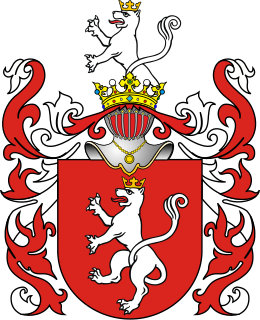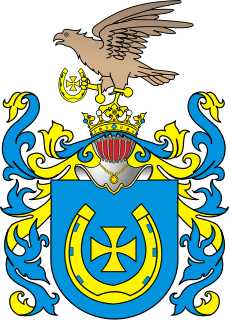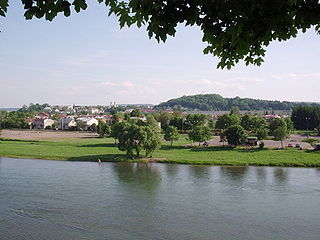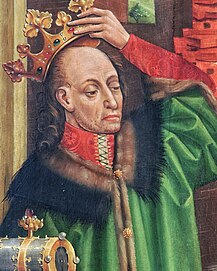
The Ruthenian Voivodeship was a voivodeship of the Crown of the Kingdom of Poland from 1434 until the 1772 First Partition of Poland. with a center in the city of Lviv. Together with a number of other voivodeships of southern and eastern part of the Kingdom of Poland, it formed Lesser Poland Province of the Polish Crown, with its capital city in Kraków. Following the Partitions of Poland, most of Ruthenian Voivodeship, except for its northeastern corner, was annexed by the Habsburg Empire, as part of the province of Galicia. Today, the former Ruthenian Voivodeship is divided between Poland and Ukraine.

Poraj is a Polish Coat of Arms. Used by several knighthood families of medieval Poland and noble families of the Polish-Lithuanian Commonwealth - those descended in the male-line from the Poraj family and those allowed into the heraldic clan by adoption.

Jerzy Mniszech was a Polish nobleman and diplomat in the Polish-Lithuanian Commonwealth. Member of the Mniszchowie family. Krajczy koronny in 1574, castellan of Radom in 1583, voivode of Sandomierz Voivodship in 1590, żupnik ruski, starost of Lwów in 1593, starost of Sambor, Sokal, Sanok, Rohatyn.

Tarnowski is the surname of a Polish noble and aristocratic family. Because Polish adjectives have different forms for the genders, Tarnowska is the form for a female family member.

Ossoliński is the surname of a Polish szlachta (nobility) family. Because Polish adjectives have different forms for the genders, Ossolińska is the form for a female family member
Jadwiga Tarło-Mniszech was a Polish noblewoman in the Polish-Lithuanian Commonwealth. Coat of arms – Topór. Married Jerzy Mniszech who was Krajczy koronny in 1574, castellan of Radom in 1583, Voivode of Sandomierz in 1590, żupnik of Ruthenia, starost of Lwów in 1593, starost of Sambor, Sokal, Sanok and Rohatyn.

Wiśniowiecki was a Polish princely family of Ruthenian-Lithuanian origin, notable in the history of the Polish–Lithuanian Commonwealth. They were powerful magnates with estates predominantly in Ruthenian lands of the Crown of the Kingdom of Poland, and they used the Polish coat of arms of Korybut.

Zboiska – village in Bukowsko borough by the Sanoczek creek, on a Bokowskie foothills, Sanok county, podkarpackie voivodship. It borders with Ratnawica village from south.

Firlej was a Polish szlachta (nobility) family. Magnates in the 15th and 17th century.

Kraków Voivodeship 1300–1795 – a unit of administrative division and local government in the Kingdom of Poland from the 14th century to the partitions of Poland in 1772–1795. Located in the southwestern corner of the country, it was part of the Little Poland province.

Tęczyński was a powerful family of nobility (szlachta) in the Kingdom of Poland, during the times of the late Piast dynasty, the Jagiellon dynasty and in the early decades of the Polish-Lithuanian Commonwealth. They were an important family from Lesser Poland (Małopolska), active in Polish politics of their time.

Zbaraski was a princely family of Ruthenian origin in the Crown of the Kingdom of Poland domiciled in Volhynia. The name is derived from the town of Zbarazh, the core of their dominions. They were the Gediminids descended from Kaributas. The line ended in 1631, with their assets overtaken by their agnates, the Wiśniowiecki family. A branch of the princes Nieświcki family.

The Sanok Royal Castle was built in the late 14th century in Sanok, Poland. The castle is situated on the San River at hill 317 m above sea level on a steep slope. Today it is the seat of the Sanok Historical Museum.

Zborowski of the Jastrzębiec coat of arms was a Polish noble family from Greater Poland, It played a significant role in Polish politics in the 16th century.

Count Marcin Kazimierz Kątski of Brochwicz was a Polish nobleman, politician, diplomat, scholar, military commander, General of Artillery of the Crown (1667–1710), the Voivode of Kiev (1684–1702) and Castellan of Kraków (1706–1710).

Tarło was a Polish magnate (szlachta) family. The seats of the family in the 16th century were, among others: Laszki Murowane near Chyrów, Sambor, Dębowiec near Jasło, Samoklęski and Potok near Krosno.

Odrowąż was an important family of knights in medieval Kingdom of Poland, strongly tied with the Catholic church in the 12th century.

The Kmita was a magnate family from Little Poland.























